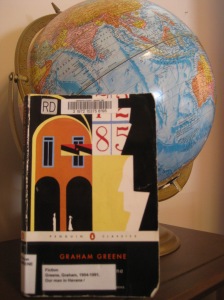Blog Archives
Graham Greene’s Edits of The Power and The Glory *Spoilers*
 Shitty first drafts; its a common phrase in the writing world and one that I personally cling on to as one of the main reasons I keep plugging away on my first novel. Editing is where the story really ties itself together. Therefore, the edits an author makes from the first draft of their novel until publication fascinates me!
Shitty first drafts; its a common phrase in the writing world and one that I personally cling on to as one of the main reasons I keep plugging away on my first novel. Editing is where the story really ties itself together. Therefore, the edits an author makes from the first draft of their novel until publication fascinates me!
Unfortunately, with the use of computers and word documents, these changes often disappear into cyber space, never to be seen or studied by anyone. BUT in 1939 when Graham Green wrote the first version of The Power and the Glory, he used good ‘ol pen and paper. That original, hand-written copy of the novel is still in tack (see pictures below!), allowing individuals to compare the original copy with the published manuscript.
See my book review of The Power and the Glory here. It may surprise you!!
While doing a bit of snooping on the Internet, I came across this intriguing article by François Gallix, a professor of contemporary literature in English at the Sorbonne in Paris. Gallix had the privilege of looking at the original version of The Power and the Glory and in doing so, he found some meaningful cuts made to the text which he describes in his article. Click here for full article.
**Spoilers ahead** The most interesting cut Gallix pointed out is near the end of the novel when the main character, a priest in Mexico during a time when all religion is outlawed, was executed in the center of town. Gallix explains the passage as follows:
The published text runs as follows:
“Then there was a single shot, and opening [his eyes] again he [Mr. Tench] saw the officer stuffing his gun back into his holster and the little man was a routine heap beside the wall—something unimportant that had to be cleared away. [added on the manuscript and published: Two knock-kneed men approached quickly].”
After “cleared away,” Greene crossed out the following lines that were not included in the published version:
“But looking down Mr. Tench caught a look on the officer’s face—an uneasy look, the look of a disappointed man and it suddenly sunk to him, as the buzzards flipped down again after the explosion’s shot, as though the blood had been cleared away from a whole region of the world.”
Gallix explains this cut as part of Greene’s “purified minimalist style,” purposely leaving things open ended so the reader can interpret the work anyway he/she sees fit. Many authors incorporate this minimalist style into their writing, Raymond Carver as one of my favorites, but seeing the actual edits first hand is a unique experience. I’m very glad that I came across this article and have the opportunity to share it with you all! Please check out the entire article here. It’s not long and well worth the time!
Review a Classic: The Power and the Glory
The Power and the Glory by Graham Greene. Published in 1940.
Originally published in 1940, under the original American title The Labyrinthine Ways, The Power and the Glory has been widely read (by the general public) and researched (by literary academics everywhere).
The ironic title is a doxology from the Christian’s Lord Prayer. The title is ironic because the main character, a priest half-heartedly avoiding capture in a state where religion has been outlawed, has very little power and no glory whatsoever. This priest, who is supposed to represent God’s message on Earth, is an alcoholic, hopeless, desperate, poor man who doesn’t trust anyone. The obvious irony of it makes the title itself a very powerful statement.
The title is not the only thing that has changed throughout the versions. One area of study surrounding the book is the comparisons of different versions of the texts, where certain, impactful lines vary. (I will discuss this more in depth in a future blog!)
Cycle
**Slight Spoiler** As many plotlines do, this story creates a circle, ending where it began. Without giving away the ending, I will say that minor characters that appear for a short time in the beginning of the novel, appear again in the last few pages, yet nowhere in-between. Also, a very important aspect of the story appears to “start over fresh” in the last few lines, suggesting that perhaps the entire story will occur again to another individual. This type of cycle is a successful plot structure because it creates the sense that the story is eternal and not unique to this individual.
Message/Theme
I don’t particularly like talking about the “themes” of stories because I don’t think every story needs to or should have one. For example, another of Greene’s novels, Our Man in Havana, focuses mainly on entertaining the reader without a clear theme. However, The Power and the Glory has a common thread that can’t be ignored. The downfall of man is present in every step of the novel. First, the novel is set in a time when the government has outlawed all religion, which is a dominant source of hope and happiness for many people. Without religion, one is led to believe that death is the end, that no eternal happiness or “life ever after” follows. Some characters in the novel even state that they believe death on Earth is the end of being.
Overall
The story was a bit too political and unclear for my liking. Names were too often averted, characters were always hiding the truth and the drama was written in a very calm tone. These things made the story hard to follow at times, and no clear goal was ever established. Even the priest’s goal of not being caught did not ground the reader because the priest himself seemed it was only a matter of time, he did not fear it, and often walked knowingly into situations that could get him caught and killed. His wishy-washy character made me not care if he got caught. Therefore, I had no real suspense or emotion invested in the story.
Most people would agree that The Power and the Glory is a 5 star novel, but my personal taste has to disagree. I’m giving it 3 stars (and honestly, it would probably be lower if there wasn’t so much outside praise influencing me.) If you’re a literary nut like me it is well worth a read and I hope you enjoy it more than I did! If you simply want to read a fun, emotional, entertaining story, I would suggest you grab Greene’s Our Man in Havana instead. Its an entertaining, funny story that incorporates a unique writing style.
Previous Book Reviews:
The Storm at the Door by Stefan Merrill Block
Jurassic Park by Michael Crichton
Future Book Reviews:
Doctor Sleep by Stephen King
The Prestige by Christopher Priest
The Main Character that Slapped Me in the Face When it’s the Last Thing He Would Ever Do

Currently reading Our Man in Havana by Graham Greene, I am shocked by the passiveness of the main character, Jim Wormold. He is a push over, letting his friends, 16-year-old daughter and even a stranger bully him into doing whatever they want.
The opening line of the novel is Wormold’s friend comparing him to a “Negro blind in one eye and one leg shorter than the other.” Clearly an insult, Wormold is confused by the suggestion and his friend eventually twists his original comment into an attempted compliment. His 16-year-old daughter bullies him into buying her a horse when they cannot afford it. In chapter three, Wormold meets an eccentric stranger who pressures him to do strange things. Wormold goes along with it all, putting up little resistance to any of it. The only actions we see him take are his typical daily routines and things that are asked of him.
Less than 50 pages into the novel, I am simply shocked by this character. He is indecisive, a slow thinker and has extremely low self-esteem. Greene is setting up a character who has let the world write his life script for him and I am very interested to see if that changes throughout the novel; to see if Wormold ever takes charge of anything.
My reaction to this character opened my eyes to the typical brave, action-driven character we are custom to seeing today. Think Harry Potter, he is always breaking rules and sneaking out at night to take action. My last book review on Stephen King’s 11/22/63 focused on a man who chose to go back in time and takes action to change the entire world. As a society, we praise doers and the characters in books and movies are only reflections of those in real life. We cherish hundreds of stories where someone took charge of their life and got a better job, lost a lot of weight, met the person of their dreams. We praise people like Steve Jobs who start with a simple idea and take action to build their own success. Therefore, it is no surprise that today’s novel and movies reflect that type of character.
Is there something wrong with praising the doer? I don’t think so. I strongly believe that if you want something, you have to go out and make it happen. But this unresisting, self-doubting, soft man has got me hooked. Less than 50 pages in, I am deeply invested in this novel. The uniqueness of this character has me wanting more and more.
*A complete book review for this novel will be posted after I complete the book. 











